What are warts? We will analyze its causes, diagnosis and treatment methods in the article of a dermatologist with 37 years of experience.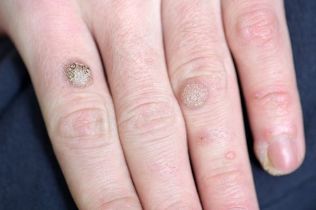
Disease definition. Cause of disease
Wartsare irregular, mildly benign skin lesions, manifested by local overgrowth of the upper layer of skin (epidermis), and papules (nodules) or plaques.
The prevalence of warts in adults is 7-12%, and it can reach 10-20% in school-age children.
Warts are very similar to other skin growths. Usually, a person cannot accurately determine the disease alone, so a dermatologist must be consulted for diagnosis.
Human papillomavirus is the cause of warts. The type of virus affects the type of warts that may be produced. Therefore, each type of human papillomavirus infects tissue with the most characteristic location.
| HPV type | Preferred Localization |
Type of wart |
|---|---|---|
| 1 | feet, knees, palms, hands, fingers |
Plantar and palm warts, are rarely simple warts |
| 2, 4 | hands, fingers, knees, less-feet |
Simple warts, Sometimes plantar, palm and mosaic warts |
| 3, 10 | glow, hands, face | Flat warts |
| 7 | hand, finger | Butcher's Wart |
| 5, 8, 9, 12, 14, 15, 17, 19-24 |
face, arms, front torso |
Verrucous epidermal dysplasia |
Virus infection usually occurs through contact-direct contact between the infected skin and healthy skin (for example, when shaking hands) or indirect (through handrails, toys, etc. ). Therefore, it is very likely to be infected with human papillomavirus, which can cause warts in many places-in public transportation, schools, workplaces, homes, high-contact and humid environments (swimming pools, saunas, gyms).
The virus enters the small lesions of the epidermis and inflammation of the skin.also contributes to the appearance of warts:
- Immune deficiency (including HIV infection);
- Warm and humid environment;
- requires professional contact with meat and fish ("sarcoma").
Certain types of human papillomavirus are transmitted through parents.
However, although toads and frogs are often scared by us in childhood, they still cannot be infected-this is one of the most common myths about this disease, and it has no basis.
If you find similar symptoms, please consult your doctor. Do not self-medicate-it is dangerous to your health!
Warts symptoms
Symptoms depend on the type of wart.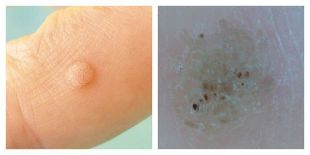
Common warts:
- Round compact papules of normal color, 1-10 mm and above.
- The surface of the pimples is covered with cracks, layered
- If there are pimples on the fingers, the marks will disappear and become deformed. The same is true for palm drawing.
- Simple warts are separate and divided into parts. They usually appear in the most severely injured areas (hands, fingers, knees).
- When viewing with a dermatoscope, the doctor may see small brown spots-thrombotic (blocked) capillaries. Patients often refer to these views as "root causes. "This is the main sign of the doctor: dermatologists can use it to distinguish warts from other similar diseases (for example, molluscum and keratoma).
Plantar (horny) warts:
- The main symptom that usually causes patients to see a doctor is pain when walking and walking.
- These warts are usually located on the feet.
- Usually, when you contact the doctor, you can see keratinized, uneven plaques of the usual color, although you can see even, smooth papules in the first stage. After keratinization, the capillaries can only be seen by removing the keratinized layer of the skin.
- The skin pattern on the sole is deformed.
- Plant warts are usually solitary, but there are also 2-6 warts;
- These warts are often confused with corn (especially dry ones)-this is a description of the problem that patients usually see.
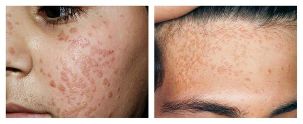
Flat warts (teenagers):
- It looks like round, transparent, smooth papules, normal, pink or brown, and the size is 1-5 mm.
- often appears on the hands, calves, and often on the face.
- always have multiple such warts-they are located in groups of
Verrucous epidermal hyperplasia (senile warts):
- Large, round, and massively fused normal pink or brown tumors.
- most often appears on the face, arms, and front of the torso.
- may be confused with keratoma, shingles and skin cancer.
The pathogenesis of warts
When the human papillomavirus enters the body, it may be in a latent state for a long time-people usually don't even know its existence. When there is a favorable factor for the virus, it begins to "multiply" in the epithelial cells, leading to tissue changes.
Unlike other viruses, human papillomaviruses do not destroy the epithelial cells themselves-they naturally die during the process of keratinization and exfoliation.
Local factors and the state of the immune system can affect the spread of infection. For example, people with HIV or kidney transplants are more likely to get warts. Moreover, these tumors are often difficult to treat. Viruses with normal immunity do not affect the deep layers of the skin, so many people will develop warts on their own after a few months.
The main stage of wart appearance is to use viruses to promote cell division and growth. This rapid metabolism causes the skin layer to thicken. Because the tissue grows in a certain small area, nodules appear, called warts.
Classification and stage of development of warts
There is no recognized classification of warts. However, there are several common variants:
- Common wartsare the most common types (70% of warts are them). Such tumors will not be felt and will only cause aesthetic discomfort.
- Planar warts-Appear on the soles of the feet and are very painful, so treatment is needed. Uncomfortable, tight, and inflamed shoes can cause skin trauma, which can lead to the development of such warts.
- Flat warts-Young people, more common in adolescents. This is due to the unstable hormonal background of young people, which affects the entire body. Usually flat warts are almost invisible.
- senile warts- are typical symptoms of the elderly. They usually appear on body parts covered by clothing, but may also appear on the face and hands. If there is no discomfort, such warts should not be treated-due to the slow metabolism, the recovery rate of the elderly may be much slower than that of the young.
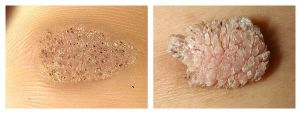
Other authors have some differences with these types of warts:
- Mosaic warts(HPV 2, 4)-vegetation on the palms and soles of the feet. They look like hyperkeratotic lesions, that is, thickened stratum corneum (usually on the forefoot) and covered with deep cracks.
- cystic warts(HPV 60) is a very rare type of growth on the feet. This is a soft knot with cracks. After opening, a curd-like yellow and white discharge appears
- Filamentous wartsare fine keratinous products near the mouth, nose or eyes.
- "Meat" warts(HPV 7)-appear on the hands and fingers of people who are in frequent contact with meat and fish. It appears as a hypertrophic neoplasm, similar to cauliflower, but normal in color.
In addition, the type of wart depends on its location.
For example, anogenital warts-tumor-like tumors that appear on the genitals (especially where the skin turns into mucous membranes) are common diseases. They are usually caused by HPV types 6 and 11.
Complications of warts
The main reason for patients with warts to see a doctor is an aesthetic defect, which affects the patient's quality of life, self-confidence and develops many complex things. Complications include rupture on the surface of the wart and increased infection. In some types of warts, you will feel sore when walking.
Skin warts usually do not degenerate into malignant tumors. They are harmless. However, in rare cases, people with weakened immune systems can still develop such complications.
When you try to eliminate growth by yourself, other complications can occur. In this regard, inflammation and aesthetic defects in the form of scars may occur, as well as the further spread of the virus in the skin. Therefore, a person may wake up with several new warts in the morning after the self-removal of warts.
Please remember that under the guise of warts, completely different diseases can be hidden, and it is impossible to be sure without the advice of an experienced doctor.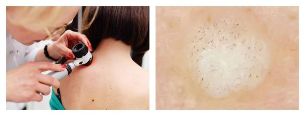
Warts diagnosis
Usually, examination (clinical pictures) and collected medical history (medical history) are sufficient to make a diagnosis.
To confirm the diagnosis, doctors can perform histological examination-study tumor cells.
Differential diagnosis is very important-distinguish warts from other diseases. For example,Common wartsmust be distinguished from the following diseases:
- Infectious molluscs- appear more on the body and genitals, rarely on the hands and feet. This is a hemisphere with an imprint on the surface; when pressed from the side, a whitish "porridge" will be emitted.
- Epidermal wart nevus-Usually a single birth, a person since birth.
- Basal sarcoma-A tumor in the form of a nodular roller with a shell covering the center. Typical elderly
Palm-foot wartsmust be distinguished from the following diseases:
- Keratinosis-large areas of keratinization and skin inflammation. Capillary without condensation
- Palm-Syphilis- Multiple painless tumors with peeling skin along the periphery. The reaction to syphilis is positive.
- Corn-Usually painless, it only causes pain when pressed vertically.
Doctors must also distinguish other types of warts from multiple diseases. If other pathologies are suspected, he can prescribe other diagnostic methods (for example, virus detection, CT or MRI antibodies).
Warts Treatment
The treatment of warts is for aesthetic purposes, with the goal of improving the patient’s quality of life. Only after examination and accurate diagnosis can a doctor write a prescription. An independent attempt to eliminate warts is unacceptable because patients without medical education and necessary equipment cannot accurately determine the disease, and the incidence of complications after such "treatment" is much higher than the incidence of rehabilitation.
There are several ways to treat warts. All these operations are usually performed under the supervision of a doctor, some of which are only performed in the treatment room of the clinic.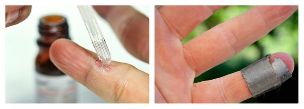
Chemical treatment
Milk salicylic acid fluffy gum and salicylic acid patches can be used to remove warts. The percentage of the drug and how it is used (long-term plaster, application, etc. ) depends on the prevalence and location of the tumor.
A solution of zinc and 2-chloropropionic acid can also be used. In this case, the chemical composition is applied to the pretreated surface, which remains on the wart until the color changes (depending on the type of wart). After 7, 14, and 21 days, repeat this process several times. Before each operation, the tissue must be mechanically removed.
Another chemical method is a combination of nitric acid, acetic acid, oxalic acid, lactic acid and copper nitrate trihydrate. In this way, only relatively small tumors are treated-up to 5 mm. Also keep the solution to change the color of the wart. After 3-5 days, the patient will be followed up, and if necessary, a second surgery prescription can be received within 1-4 weeks.
Encryption
This method involves freezing the wart with liquid nitrogen: pressing a wet swab onto the damaged skin (capture the surrounding tissue a few millimeters) for 1-5 minutes. Some lesions require four weeks to undergo several treatments before they can be destroyed.
Compared with other methods, the main disadvantage of cryo-elimination is pain and delayed effect, while other methods usually only need one step to remove.
Electrocoagulation
Under the influence of electric current, warts are removed layer by layer. This operation is performed under local anesthesia.
This method is more effective than cryoablation, but it has an obvious disadvantage: electrocautery often leaves scars on the site of wart removal. For those patients seeking cosmetic repair, this method will not be the most suitable method.
Laser destruction
The laser can also remove warts layer by layer. The light guide touches the skin from a few seconds to three minutes depending on the size. Then remove the sore that appeared, and treat the bottom of the wound with laser again. Then instruct the patient how to treat the wound. The operation itself is performed under the influence of local anesthesia.
Radio Wave Surgery
Radio wave surgery is one of the most modern and gentle methods to remove benign tumors including warts.
This method is based on generating electromagnetic waves of different frequencies: from 100 kHz to 105 MHz. During this process, the tissue resists the passing waves, which is why the molecules can be released in the cells to heat the skin. Under the influence of the heat, the cells actually evaporate-a neat cut is obtained. At the same time, no mechanical force is exerted on the affected tissue.
Advantages of this method:
- Security;
- Fast wound healing;
- Good cosmetic effect-scars and scars are excluded;
- Relatively painless-apply local anesthesia before minor surgery;
- excludes secondary infections caused by the automatic disinfection of electrodes when the device is turned on.
The effectiveness of this method has been recognized all over the world, but it is difficult to find a clinic that uses radio wave surgery.
Choose which processing method
All the above methods have some disadvantages:
- In the first few weeks, the surgical area looked unattractive-knots, and tissues turned black. If warts are found on visible parts of the body (for example, the face), they should be considered.
- Unpleasant smell and a certain degree of pain during the operation
In addition, each method has contraindications, and you need to understand these contraindications in your initial consultation with a dermatologist.
But the main disadvantage is that the possibility of recurrence ofis high, especially if the warts are widely distributed. Since today, using each of these methods, doctors will not fight the root cause of the disease, but will fight its consequences.Human papillomavirus cannot be cured.
Therefore, the treatment is aimed at:
- or destroy the tumor that appears at the site where the virus is introduced;
- can stimulate the antiviral immune response;
- or a combination of these methods.
Destructive treatment is most often used. Their efficiency reaches 50-80%.
Childhood is usually not a contraindication to surgical treatment. Therefore, many of them (including radio wave surgery) are also used to treat warts in children. Because of the potential for adverse reactions to the substance, chemical removal of warts is an exception.
Operation
After the operationAfter performing any of these operations, be sure to follow the doctor’s advice.
After removing the tumor by any of the methods described, the doctor usually prescribes the treatment of the removed site. It is prohibited to remove the "skin" by yourself, wet the wound and expose it to direct sunlight.
If the patient often suffers from warts, an immunologist should be consulted-medications may be required, which will increase the immune resistance to human papillomavirus manifestations.
Forecast. Prevention
If the patient does not have an immunodeficiency, then the wart can go away on its own, but it will take a long time-from months to years. Therefore, in 65% of cases, the warts resolve independently within two years. If the wart still exists after two years, it is recommended to remove it. It is recommended to delete multiple growths immediately.
has normal immunity and correct removal method (depending on the size and type of warts), which can remove pathogenic tissues and achieve good cosmetic results. Due to reduced immunity and other risk factors, the human papillomavirus remaining in the body can cause relapse.
There are no specific disease prevention measures. But is infection inevitable?
If you follow the following rules, you can reduce the possibility of viruses:
- Avoid walking barefoot in public places (swimming pools, public showers, gyms) that may cause skin damage and virus infection.
- Choose high-quality footwear and replace it frequently. Try to keep your feet dry. Heat and moisture are excellent breeding grounds for human papillomavirus
- To avoid genital warts, only go to certified nail technicians and make sure they use sterile instruments.
According to the WHO (World Health Organization), the quadrivalent vaccine against human papillomavirus is also very effective to prevent anogenital warts. There is currently no vaccine to prevent other types of warts.
If you find a wart, please don't try to burn, cut or remove it yourself-this way you can promote inflammation and spread the virus further in the skin. After this "removal", you can wake up at ten in the morning instead of a wart in the morning.













































































